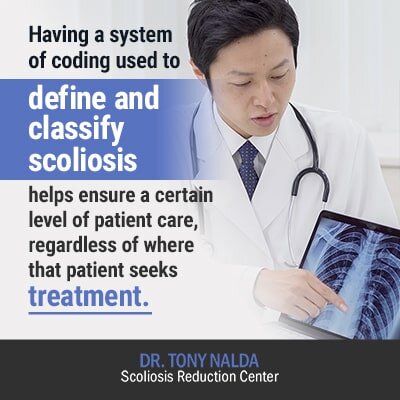A few years back, the United States government and the American Medical Association developed a new system of diagnostic coding for classifying diseases and disorders. It was called ICD 10, an acronym for International Classification of Disease, and the ‘10’ is the edition number. Classifying a condition like scoliosis is important because it clearly communicates to health-care professionals what type of scoliosis they are dealing with; this is especially important in conditions, like scoliosis, that can take many forms.
4 Key Takeaways
- Comprehensive Classification and Diagnosis: The use of ICD-10 codes provides a standardized system for classifying scoliosis, considering the time of diagnosis, causation, and curvature location. This enables precise communication among healthcare professionals and informs effective treatment strategies.
- Impact of Scoliosis Type on Treatment: Identifying the specific type of scoliosis, whether idiopathic, congenital, neuromuscular, or degenerative, is crucial for tailoring treatment plans. The ICD-10 codes help in categorizing the condition accurately, ensuring that patients receive the most appropriate care for their specific form of scoliosis.
- Role of ICD-10 in Healthcare Communication: The ICD-10 coding system plays a vital role in streamlining diagnosis and treatment processes across different healthcare settings. It provides a common language that aids in the efficient transfer of patient information, contributing to continuity of care and treatment optimization.
- Importance of Accurate Coding for Treatment Efficacy: Accurate ICD-10 coding is essential not only for documentation purposes but also for designing customized treatment plans. By fully understanding a patient’s condition through detailed coding, healthcare providers can implement targeted interventions that address the unique characteristics of the scoliosis and its impact on the patient’s life.
Before we go into the specific codes for scoliosis, let’s first take a look at what goes into classifying the condition, such as time of diagnosis, causation, and curvature location.
Scoliosis Classification Details
When a patient’s scoliosis is classified, when their condition was first diagnosed is what the final classification is based on. In other words, if a patient was first diagnosed with scoliosis when they were a teenager, but as the condition was mild, they didn’t seek out active treatment until well into adulthood, the case would still be classed as adolescent scoliosis, not adult scoliosis.
This is important because the reason behind the original onset of a condition or disease helps indicate what form of treatment would be most effective. Particularly with scoliosis, as a progressive condition, when it’s first diagnosed is even more important because condition characteristics can change so substantially over the years.
Causation
Determining causation is not an easy thing with scoliosis. The condition’s main form, adolescent idiopathic scoliosis, has no known single cause, which is why it’s classified as ‘idiopathic’. However, there are some forms of the condition with known causes, such as congenital, neuromuscular, degenerative and traumatic, and the ICD 10 codes will reflect the cause, if known.
Location of the Curvature
There are three main sections of the spine: cervical (upper back and neck), thoracic (middle back), and lumbar (lower back). While scoliosis most commonly develops in the thoracic region, it can develop anywhere along the spine, which is why location is another important classification point.
What are ICD 10 Codes for Scoliosis?

Now that we’ve explored the main condition characteristics that go into classifying scoliosis and finding the right code, let’s take a look at some of the most commonly used ICD 10 codes for scoliosis. As so many cases of scoliosis don’t have known causes, the idiopathic condition codes are most commonly used.
Adolescent Idiopathic Scoliosis (code M41.12): as mentioned earlier, scoliosis is most commonly diagnosed between the ages of 10 and 18. This group represents approximately 80 percent of diagnosed cases, and there is no known single cause with this form.
Scoliosis isn’t always easy to catch, especially in its milder forms or early in the condition’s progression. With adolescents, pain is rarely present, making it more difficult to notice, and postural changes are often subtle and would only be noticed by a specialist who knows how to recognize those subtle signs.
Infantile Idiopathic Scoliosis (code M41.00): infantile idiopathic scoliosis is defined as scoliosis diagnosed in infants between birth and the age of 3. Again, this form is idiopathic, so causation is unknown.
While some cases of infantile idiopathic scoliosis resolve on their own, for those that don’t, as growth is the main trigger for progression, these infants face the likelihood that their curvature will progress to severe levels in later life.
Juvenile Idiopathic Scoliosis (code M41.11): juvenile idiopathic scoliosis is defined as scoliosis diagnosed in individuals between the ages of 3 and 9 with no known single cause.
Again, as growth is such a big trigger for the condition’s progression, this age group faces a high risk of progression because they have so much growth yet to go through.
Additional Idiopathic Scoliosis Conditions (code M41.2): this code is used for any other conditions that remained undetected prior to the patient reaching skeletal maturity. Most often, skeletal maturity is considered to be reached around the age of 18, but of course, this isn’t exact and differs case by case.
Cases of degenerative or adult ‘de novo’ scoliosis would also fall into this category. These cases are classed as ‘de novo’ because they have developed fresh in adulthood, after skeletal maturity has been reached, with no prior history of having the condition.
These types of cases often involve patients who are over 40 and facing degenerative changes to the spine and the discs that cushion the spine’s individual vertebrae.
Congenital Scoliosis (code Q76.3): congenital scoliosis is one of the condition’s forms with a known cause, which is a congenital bone malformation, like a hemivertebra, that’s present at birth.
In congenital scoliosis, there is a malformed vertebrae that throws off the alignment of the spine. In a healthy spine, the vertebrae are stacked on top of one another like rectangular bricks; in congenital scoliosis, picture one of those vertebrae as triangular in shape, and you can imagine how much that would throw off that stack of vertebrae and cause the spine to slip to the side.
Congenital Spinal Deformity (code Q67.5): this code is used for patients with congenital scoliosis that wasn’t caused by a bone malformation and for other cases of congenital scoliosis that don’t fit into another code.
Neuromuscular Scoliosis (code M41.4): neuromuscular scoliosis is another form of the condition with a known cause. This code is used to classify scoliosis that develops as a secondary complication of neuromuscular disorders; these would include cerebral palsy, muscular dystrophy, spina bifida, etc.
Obviously, there are many more codes that go with the different forms of scoliosis, and conditions with specific scoliosis-related complications such as cardiac issues or lung impairment have their own codes to further specify the condition.
When it comes to documenting spinal conditions, ICD-10 codes play a crucial role. For dextroscoliosis, you would typically use the ICD-10 code M41.9 for the diagnosis. This code, part of the ICD-10-CM code for scoliosis, can be employed for various types of scoliosis, including dextroscoliosis. If a patient has a history of scoliosis, the ICD-10 code for a history of scoliosis (hx of scoliosis ICD-10) may be used to capture their medical background.
Furthermore, lumbar levoscoliosis, a specific type of spinal curvature, has its distinct ICD-10 code for accurate diagnosis. It’s crucial to differentiate between the types of scoliosis since they might result from various causes, including postural, congenital factors, bony malformations, postradiation scoliosis following radiation therapy, and postprocedural scoliosis after certain medical interventions. In some cases, scoliosis may be associated with other medical conditions, such as kyphoscoliotic heart disease, necessitating comprehensive documentation to ensure accurate treatment and care.
When assigning ICD-10 codes for scoliosis, healthcare professionals consider factors such as the type and location of the curvature, with codes specific to conditions like cervical lordosis and thoracolumbar lordosis to accurately document the patient’s diagnosis.
Why are Medical Coding Guidelines Important?
When a condition is first diagnosed, it has to be comprehensively assessed. This comprehensive assessment involves looking at a number of characteristics involving the patient and their condition and documenting those findings.

The current procedural terminology (CPT) used by the American Medical Association and the ICD are working to classify medical diseases and conditions as thoroughly and consistently as possible.
Having a common language and system of coding used to define and classify scoliosis helps ensure a certain level of patient care, regardless of where that patient seeks treatment.
Initial scoliosis coding and sequencing will depend upon the doctor that first diagnoses and documents the condition. If there is a consistent system for classifying scoliosis, different doctors, specialists, and health-care professionals can have a common understanding of the form of the condition they are treating and the requirements that have to be met to accurately define and classify it.
So we know that complete and accurate coding is beneficial to the team of health-care professionals treating a specific patient, but it is also necessary to ensure that an effective treatment plan can be designed and implemented.
Through comprehensive coding, that team will know everything they need to know about the condition to be able to design a customized treatment plan. A treatment plan that is customized accordingly will address the individual characteristics of the patient and the form of scoliosis they are dealing with.
As we have seen, scoliosis is not a simple condition to treat as it ranges widely in severity and can take on many forms. Having a comprehensive and accurate coding system in place addresses this complexity and establishes a method for streamlining the diagnosis and treatment process amongst health-care professionals.
Conclusion
Understanding ICD-10 codes for scoliosis is essential when it comes to proper medical documentation. These codes help classify and identify different scoliosis types, including levoconvex scoliosis, and various scoliosis curvature types. By utilizing the appropriate ICD-10 codes, healthcare professionals can accurately categorize and communicate the specific nature of the patient’s scoliosis, facilitating effective diagnosis and treatment.
A person might think, “Scoliosis is scoliosis. A crooked spine is a crooked spine,” but as we have learned, there are many different types of crooked spines, and these different types necessitate different forms of treatment.
A necessary step in defining and classifying scoliosis is taking into account when a patient was first diagnosed with the condition, not necessarily when they first started treatment. Cause of the condition, whether known or unknown, is important because it tells us if we are dealing with a ‘typical’ or ‘atypical’ form of the condition. Where along the spine the scoliosis develops is also important because it helps us further classify the condition and know where to focus our adjustment efforts.
The types of ICD 10 codes for scoliosis are most important in terms of treatment efficacy. Clearly, we want the best for our patients, and here at the Scoliosis Reduction Center®, out treatment approach centers around customization.
Having a system of codes and terminology in place helps us understand another doctor’s assessment and diagnosis and also helps us comprehensively assess and diagnose the patients that walk through our doors.
Regardless of where you are in the progressive line of your condition, seeking active treatment is always the best choice.
Together, we can help guide patients on how best to integrate their condition as positively as possible into their life and future goals.





